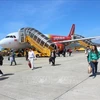Ten months after it was kicked off, the programme for cooperation in farm produce and food supply between Hanoi’s agricultural sector and those of 18 northern provinces and cities has beared fruit. Report by Vietnam Economic News.
Attracting safe farm produce and food to Hanoi
Early this year the Hanoi Department of Agriculture and Rural Development signed agreements on the sale of safe vegetables, fruits, food, forest products and seafood with its counterparts in northern provinces and cities. Ten months after the agreements were kicked off, all participating localities have successfully worked together.
Nam Dinh province Department of Agriculture and Rural Development Deputy Director Nguyen Phung Hoan said that after signing the agreement, the amount of farm produce and food that Nam Dinh provided for Hanoi increased and the trade in these products between the two localities became more favourable.
Since early this year, Nam Dinh has supplied to Hanoi about 100,000 tonnes of high-quality rice, 20,000 tonnes of fruit and vegetables, and 50,000 tonnes of seafood. Policies on cooperation in controlling food safety and hygiene were formed and applied rather effectively, Hoan said.
Thai Binh province Poultry and Agricultural Farm Association Chairman Quach Thuoc said that Thai Binh was supplying to Hanoi pork, chicken meat and eggs, fruit and vegetables (12,000 tonnes of pork, 350 tonnes of chicken meat, 4.5 million chicken eggs, 3.3 million duck eggs, and 30,000 tonnes of gourd per year). All of these products were produced according GAHP (Vietnamese Good Animal Husbandry Practices).
In the first 10 months of this year, Thai Nguyen province launched onto the market 7 million poultries and about 500,000 pigs, 50-60 percent of which were sold to Hanoi. According to Thai Nguyen Province Veterinary Division Deputy Director Pham Quang Phuc, the cooperation has opened up mechanisms to better control animal products of unknown origins in Hanoi and provinces.
Lao Cai, Son La and Vinh Phuc provinces worked with Hanoi to produce and sell safe vegetables. About 10 tonnes of naturally raised chicken meat from Yen The in Bac Giang province were sold in Hanoi daily.
Increasing connectivity between localities
Although it hasobtained initial achievements, the programme still needs to be improved as its range of products remains poor and the programme has not satisfied market demand in terms of quantity.
Hanoi Department of Agriculture and Rural Development Director Hoang Thanh Van said that agricultural businesses in the capital have met only 69, 32, 84, 33 and 18 percent of the city's demand for cattle meat, fish, poultry eggs, fresh vegetables and fresh fruit, respectively. Therefore, Hanoi needs to import safe farm produce and food from other provinces and cities.
At a recent conference reviewing 10 months of cooperation between the Hanoi Department of Agriculture and Rural Development and its counterparts in the 18 provinces and cities, representatives from localities expressed desire to increase the connectivity between the participating parties, including that with businesses and co-operatives to invest in the production and sales of agricultural products for farmers.
Lao Cai province Department of Agriculture and Rural Development Director Ma Quang Trung proposed that Hanoi expand cooperation with Lao Cai in the production and sales of products that are Lao Cai’s strengths, such as Seng Cu rice, tea, off-season vegetables, highland fruit (pears, peaches, plums, grapes, kiwi and cherry), black pig and black chickens.
The Hung Yen province Department of Agriculture and Rural Development also proposed that Hanoi increase cooperation with the province in sales of products that are its strengths, such as fruit and ordinary rice.
Hanoi Department of Agriculture and Rural Development Director Hoang Thanh Van said that to increase connectivity in product sales between Hanoi and the other provinces and cities before, during and after the coming Lunar New Year which will fall by the end of the next January, localities should strengthen cooperation and information exchange in order to control the quality of products to be launched onto the market, improve accountability in disease prevention and quarantine, and control cattle slaughtering and origins to help protect consumers.-VNA



















